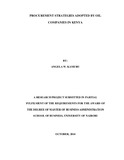| dc.description.abstract | This study sought to determine procurement strategies adopted by oil companies in
Kenya to develop competitive advantage and to establish the challenges of
implementing procurement strategies by oil companies in Kenya. To achieve the
objective of this study, the researcher used a descriptive survey. The population of the
study was 72 oil companies in Kenya registered by Petroleum Institute of East Africa
(PIEA).The sample size for this study constituted 34 oil companies in Kenya. This
study used both primary data and secondary data sources. Primary data was collected
using a semi structured questionnaire. A Likert-type scaling measure was used to
examine the constructs for each of the participating companies. The questionnaires
were administered by drop and pick later method at an agreed time with the
researcher. Secondary data was collected from various sources including various
reports and records of past events that were also reviewed to compile evidence of
competitive strategies that have been observed. Quantitative data was collected using
a questionnaire and was analyzed by the use of descriptive statistics using the
Statistical Package for Social Sciences (SPSS) and presented through percentages,
means, standard deviations and frequencies. The information was displayed by use of
tables and pie charts. Qualitative data was analyzed using content analysis which is
the best suited method of analysis. The study concludes that most oil companies in
Kenya adopted procurement strategies in order to cope with stiff competition in the
oil industry. Some of the most notable strategies that were adopted by most of the
firms were namely: recruiting and retaining professionals, aligning and staffing the
supply chain organization, processes and controls, establishing alliances with key
suppliers and engaging in collaborative strategic sourcing. The study also concluded
that corruption, lack of a strategic plan and poor technologies were the main
impediments towards attaining competitiveness among oil companies in Kenya. The
study recommends that oil companies should invest in modern technologies that will
enhance integration, information sharing, improved decision making processes and
procedures and form a link between the suppliers, service providers and the
organization. There is also the need to outsource competent professionals and experts
to provide training and educate them on the best practices of implementing
procurement strategies that meet local and international standards, in order to compete
globally with the best. The researcher also faced significant time and funding
constraints which limited the scope of the study. It would have been more useful if the
study involved all the oil companies in Kenya other than using a sample. A
comparative study can be carried out to establish procurement strategies adopted by
firms in other industries other than the energy sector and the benefits derived from
these strategies. This will assist in comparing the level of supply chain performance
with other firms and thus concrete facts and reliable conclusions can henceforth be
drawn. These findings will play a significant role in policy formulation by the Public
Procurement Oversight Authority (PPOA). More importantly, the Public Procurement
Oversight Authority will provide an enabling environment for oil companies to
compete fairly. This will ensure compliance with the Public Procurement and
Disposal Act and enhance the capacity of stakeholders in the public procurement
process in order to increase the general public's understanding and demand for
procurement reform, and the role of the PPOA in particular. | en_US |

